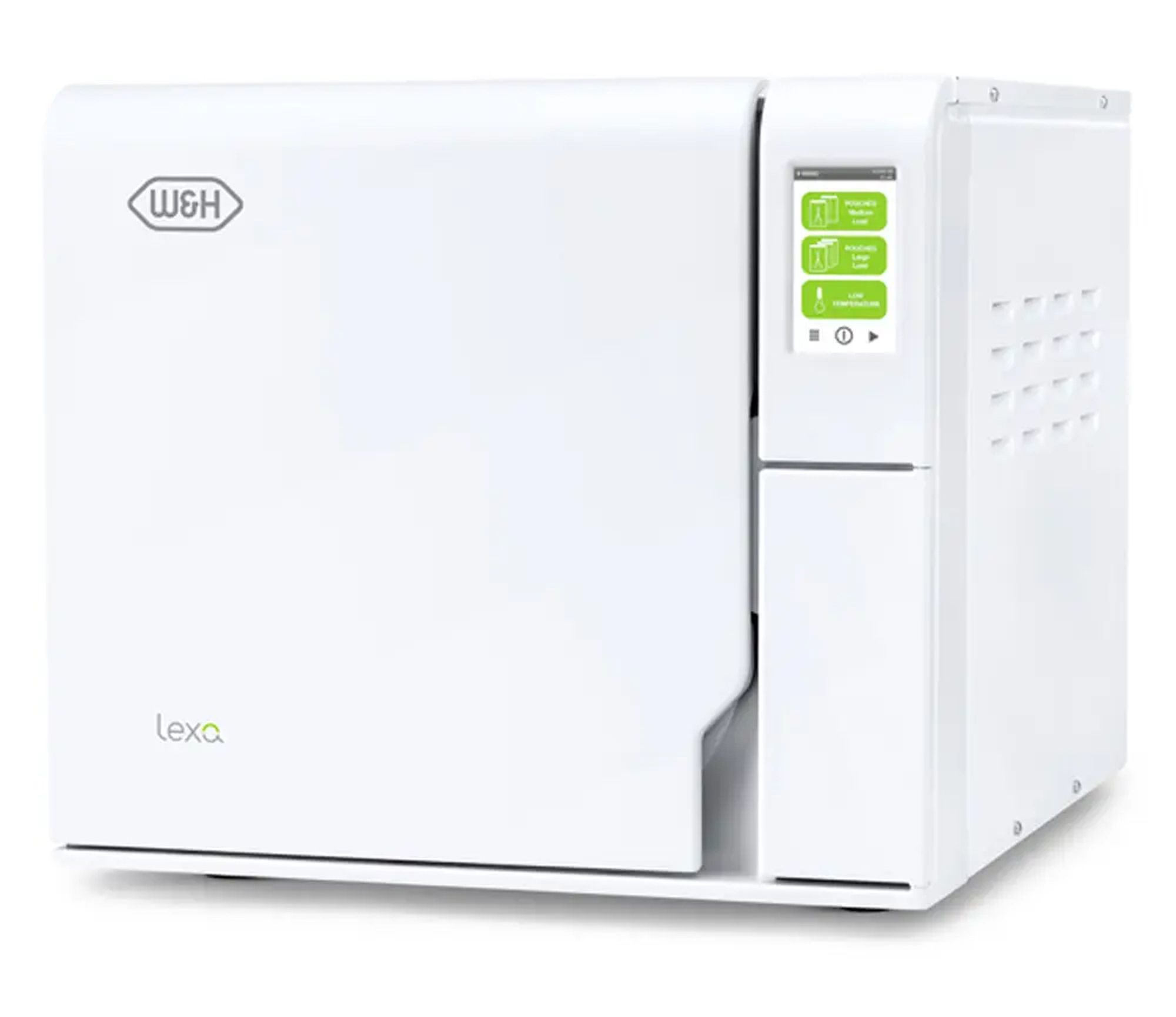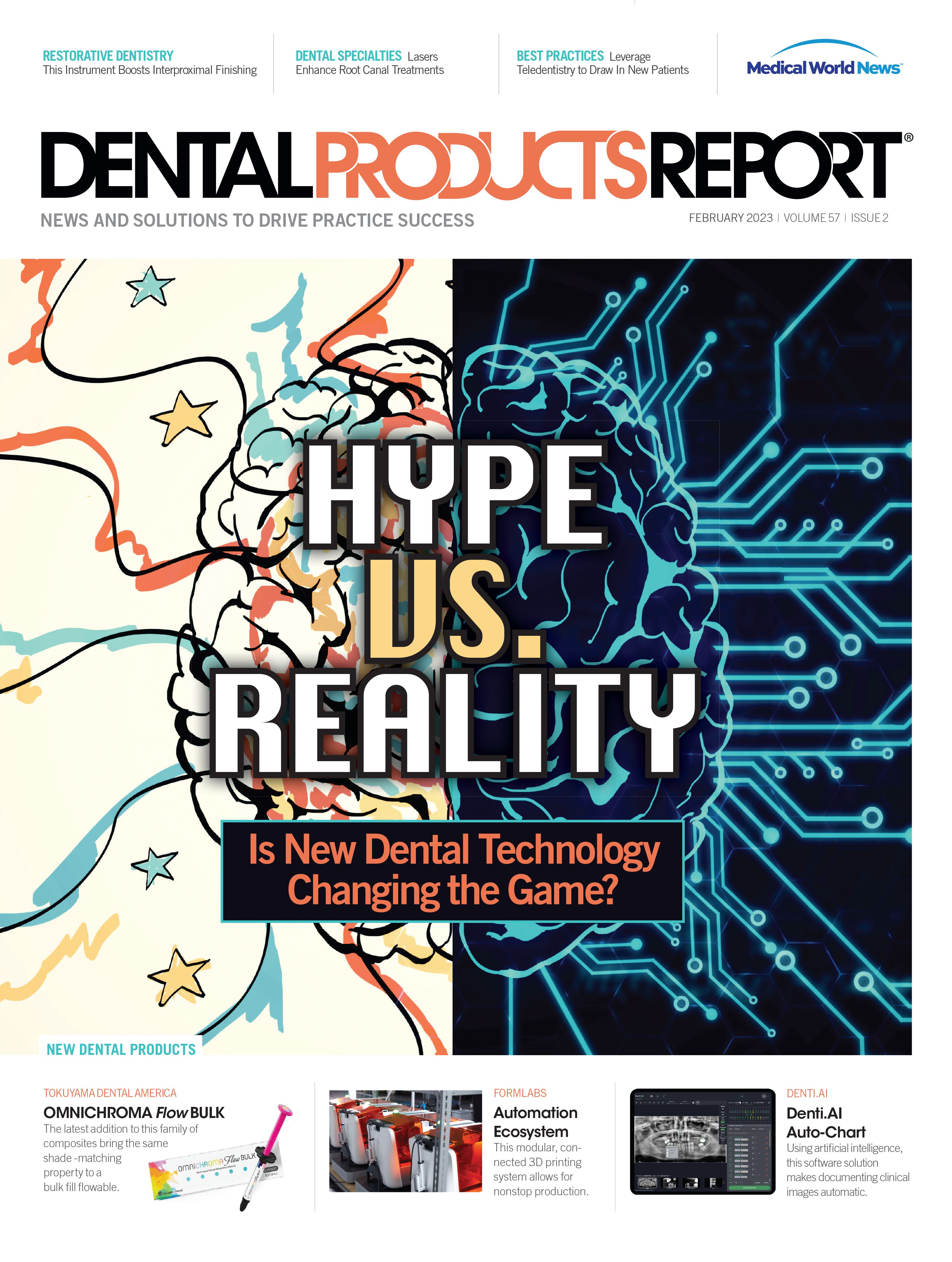Sterilizers are essential in the dental practice, making safe and successful operations possible. As one would expect, top-of-the-line equipment with cutting-edge features offers significant benefits.
Meet Lexa
“Lexa is a steam sterilizer launched in North America in 2019,” says Alberto Borghi, product manager at W&H Sterilization, in Brusaporto, Italy, where Lexa is manufactured. “Until 2014, W&H sold another device, called Lisa. We decided to move a step forward and create a specific sterilizer for North America.”
Lexa is the company’s first sterilizer to have a 7.4-gallon chamber and a range of cycles that satisfies the needs of US and Canadian clinics in terms of maximum item quantity (up to 18 pounds) and type of load. It can reprocess wrapped and unwrapped instruments, which can be inserted in cassettes, without any limitation on the type or combination of items, except for instruments that are not amenable to steam sterilization.
Lexa
Featuring a high-capacity inside and ideal dimensions outside, the Lexa sterilizer is designed to fit perfectly into your reprocessing room. The efficient sterilizer offers different cycles to fulfill the individual needs of different practices. It meets hygiene standards with its closed-door drying process using high-efficiency particulate air filters and the use of fresh water for each cycle. Other features to enhance the user’s workflow include optimal efficiency, flexibility, speed, and protection.
W&H
800-265-6277 | wh.com
Critical to a sterilizer’s function is its ability to quickly dry instrument pouches once sterilization has been completed. “Only perfectly dried pouches or wrapped cassettes can maintain the sterility of the instruments inside,” Borghi explains. And W&H’s “patented, closed-door, vacuum-assisted drying technology permits a bone-dry result in a shorter time…. The negative pressure generated during this stage…cuts [down] the time necessary for drying.”
In addition, the ease with which staff can use the equipment makes for a better experience. “Lexa is…recognized on the market as an intuitive device,” Borghi points out. “A 4.3-inch capacitive touch-screen display offers clear information, and the user interface simplifies daily activities…. Furthermore, the high-quality display is also usable with [the] gloves…worn by assistants…in the sterilization room.”
But the Lexa’s best features may be under the hood. “To meet the highest hygiene standards, Lexa has 2 water tanks: one…to store [the] distilled water necessary during [sterilization and] one to store water used after the cycle,” says Borghi, which “guarantees…high-quality steam to perform a safe sterilization cycle.” Lexa’s features reduce long, arduous sterilization for dental practices, allowing additional time to dedicate to the most important aspect, taking care of their patients.
Innovation
Speed makes all the difference when it comes to sterilizing instruments, and W&H prides itself on Lexa’s performance. “A faster sterilization cycle permits dental practices to…optimize the stock of instruments and [the] planning of activities,” Borghi says. “Lexa offers the fastest cycle time in its category, including drying, and peace of mind for the practice. The trickiest items to sterilize…are the handpieces due to [their]…small tubes and hollow parts, but Lexa can reprocess up to 100 handpieces per cycle, both wrapped and unwrapped.”
Of course, dental practices don’t just use a single type of instrument, so sterilizers must be able to process different ones safely and efficiently. “Lexa offers a standard rack for 4 trays or cassettes; in addition, a rack for 3 trays is available to accommodate larger cassettes…[and] a 5-tray rack if clinics use mainly…pouches,” Borghi adds.
Moreover, the sterilizer’s smart capabilities make it especially useful for dental practices. “A clear difference [between] Lexa and…other devices is [its] connectivity and traceability,” says Borghi. “Lexa comes with 5 USB ports and an Ethernet port [allowing users] to connect the sterilizer to the clinic’s network via Wi-Fi, thanks to a dongle key, or via Ethernet to automatically save the cycle reports directly on a PC. Thanks to [this] connectivity, it is also possible to use W&H’s Steri App to monitor and create an additional backup of the cycle reports. The mobile application, developed by W&H Sterilization, is also able to send notifications at the end of the cycle to inform…assistants and doctors about device status (eg, when the sterilization cycle is complete). Lexa is also equipped with a USB stick in the front service panel. At the end of each cycle, the report is automatically saved [onto] it with all [the] information about cycle parameters.
“Regarding traceability,” Borghi continues, “W&H is state of the art in the dental world. Simply through a label printer and a bar code scanner, it is possible to create a link between the cycle, the pouch or wrapped cassette, and the patient for the clinic’s peace of mind.”
But that’s not all. Lexa continues to evolve as W&H develops additional features, 2 of which were introduced in 2022. The first, EliTrace, allows users “to create a database of all the clinic’s instruments [that are] in the sterilizer [during]…each cycle.” And with the W&H Steri App, it is possible to check instrument status in front of patients to show them that they are indeed sterile.
Reporting is also a key component of a practice’s infection control and prevention, and Lexa streamlines that process as well. “All sterilizers must be tested at least [weekly] to check that they work properly according to ST79 guidance for steam sterilization. Currently…assistants must manually fill out a log with all the details.” However, “Lexa is…able to create a digital report and link the spore test to a specific cycle,” says Borghi. “In addition, after 24 hours…a pop-up reminds the user to check the result and validate it.” These features can be added to models purchased before 2022 with a software update.
Effectiveness
During the past 3 years, patients have become more aware of safety measures at dental offices. Key to those efforts is ensuring that patients feel safe with the instruments being used for their care.
“After the COVID-19 crisis…hygiene and reprocessing…became more and more important,” Borghi notes. “In order to have sterile instruments in front of patients, it is necessary to pouch or wrap them and regularly check the status of [the] packaging materials after…sterilization…. Only perfectly dried and intact pouches or cassettes can remain sterile during the storage period. Lexa offers a high drying quality thanks to the closed-door, vacuum-assisted technology and the HEPA filter,” says Borghi. “During the drying stage, only filtered air is in contact with pouches, wrapping material, and instruments in order to not contaminate the load.”
Efficiency is also highly valued by all members of the dental team. “Routine activities can be…simplified thanks to the user-centered Lexa interface,” says Borghi. “It’s possible to hide…cycles [not being used] to simplify the home screen appearance and reduce mistakes. The delayed cycle start allows cycles to run at night or in the early morning before the clinic…open[s].
With respect to water filtration, Lexa can be connected to “demineralizers or reverse osmosis [systems], thanks to automatic water-filling valves.” Likewise, it’s possible “to drain the water from the dirty water tank via automatic…drain valves. Lexa uses only fresh water for every cycle—never recycled water—to ensure optimum sterilization.”
Something for Everyone
“Thanks to the wide range of…features, all types of practices can benefit from Lexa,” says Borghi. Large practices can take advantage of fast cycle times, workflow optimization, and automatic water management while smaller clinics benefit from the intuitive interface, automatic documentation, and different cycles that allow for the management of workload peaks. And “clinics focused on traceability have a clear optimization of their process via…a digital report for spore tests and EliTrace,” he adds.
Developed for North America
W&H didn’t just develop Lexa in an isolated workshop. Consultation and research at dental practices helped the company deliver desired features and even take into account the size of the furniture typically used in North America.
“We visited several clinics in the United States and Canada to better understand the…needs and expectations of the final users [and] Lexa was developed specifically for the North American market. For example, its chamber has a diameter of 11 inches, particularly requested in [the] US and Canada. We…optimized the drying phase by testing different types of wrapping materials…common in North America but not in other countries. And, of course, “Lexa meets the North American standard ST55 [for tabletop steam sterilizers].”
Once desired features—shorter cycle times and the ability to reprocess all instrument types—were identified, “the R&D team spent a lot of hours to obtain the best performance possible.” Because drying has become important in the past few years, W&H decided to focus on that “to clearly differentiate our device from the others. The result is the patented closed-door vacuum-assisted drying technology [that ensures] perfect drying in a shorter time.”
Ultimately, Lexa delivers everything a practice needs in a sterilizer.
“Lexa was the first milestone to recreate a connection between W&H and North American clinics,” says Borghi. To continue being a trusted partner, W&H works with users and visits their facilities to discuss requirements. “Thanks to this information, other devices and accessories are arriving on the market [like] the new Bowie-Dick test with unique traceability features to link the test to the cycle [and] water-treatment devices such as the Multidem and Osmo.”
Although sterilizers are well established, ubiquitous pieces of equipment, they can always be modernized and improved, and that has been the case with the W&H Lexa. “During 2023, the launch of new products is expected to offer even more to fulfill current and future needs of dental practices,” Borghi says, so “stay tuned!”

